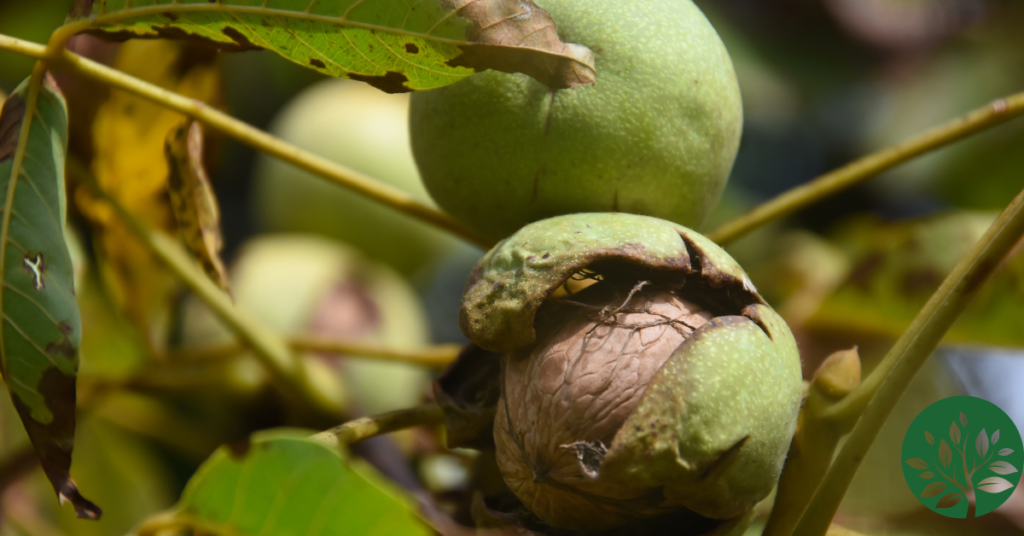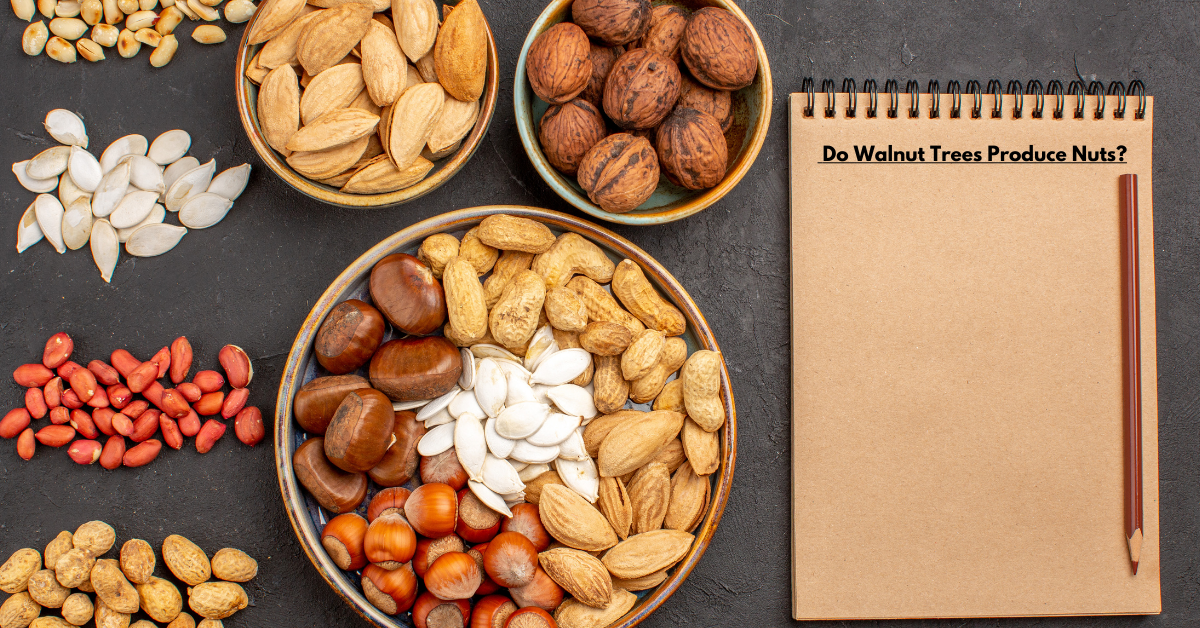Walnut Trees Produce Nuts.Walnut trees are prizes not as it were for their excellent wood but moreover for the scrumptious nuts they create. If you’re pondering when walnut trees bear nuts, you’ve come to the right put. Understanding the development and fruiting propensities of walnut trees can offer assistance you expect when to anticipate a bountiful harvest.
Growth and Advancement of Walnut Trees

Walnut trees, experimentally known as Jungian, have a place to the Graceland family and are famous for their hardwood and nutritious nuts. These trees ordinarily develop in mild climates and can reach amazing statures, regularly surpassing 100 feet. They are deciduous, meaning they shed their takes off yearly in the fall.
Walnut trees, experimentally known as Jungian recapture, are captivating plants eminent for their important wood and scrumptious nuts. Their development and advancement envelop a few stages, each impacted by natural variables, hereditary qualities, and administration practices.
Seed Germination and Early Growth
Walnut trees ordinarily start their life cycle from a seed, encased inside a intense external shell. Germination is activated by great conditions such as damp soil and direct temperatures. Once sprouted, the seedling rises with its essential root (taproot) and introductory set of clears out (cotyledons). These early stages are significant as they set up the establishment for future growth.
Seedling and Sapling Stages
During the to begin with few a long time, walnut seedlings centre on building up a solid root framework. The taproot expands profound into the soil, giving solidness and getting to supplements and water from lower layers. Over ground, the seedling creates a central stem and starts branching, shaping its introductory system. This organise is touchy to natural stressors like dry season, bothers, and competition from other plants.
Juvenile Stage and Canopy Development
As the tree develops past the sapling organise, it enters a period of quick development known as the adolescent stage. This stage is characterise by energetic vertical and horizontal development. The tree contributes vitality in creating a strong trunk and branching structure to back future canopy development. Canopy advancement is basic for photosynthesis and regenerative victory, affecting nut generation in develop trees.
Adolescent Stage
The adolescent arrange alludes to the early stage of development in plants, ordinarily after germination and expanding until the plant comes to regenerative development. Amid this arrange, plants experience critical physiological and morphological changes as they move from seedlings to develop people able of generation. Key characteristics of the adolescent arrange include:
- Vegetative Development: Adolescent plants centre basically on vegetative development, building up their root frameworks and creating their above-ground structures such as stems and clears out. This stage is basic for the plant to assemble assets and construct basic integrity.
- Vulnerability: Adolescent plants are regularly more defenceless to natural stresses such as dry season, malady, and herbivore compared to develop plants. They may need the strong protections and asset saves that develop plants have developed.
- Adaptability: The adolescent arrange is a period of versatility and responsiveness to natural signals. Plants may show versatility in their development designs, altering to light, water, and supplement availability.
- Duration: The term of the adolescent organise changes broadly among species and natural conditions. Components such as light escalated, temperature, soil quality, and competition can impact the length of this phase.
- Phase Alter: In a few plants, the move from the adolescent to the grown-up stage is checked by physiological changes known as stage alter. This move is frequently related with changes in leaf morphology, blooming behaviour, and regenerative capacity.
Maturity and Regenerative Phase
Walnut trees regularly reach regenerative development between 4 to 10 a long time, depending on natural conditions and hereditary qualities. Amid this stage, the tree designates assets to bloom and natural product generation. Walnut trees are dull, meaning they have partitioned male and female blooms on the same tree. Fertilisation is frequently encouraged by wind, in spite of the fact that creepy crawlies can too play a role.
Nut Generation and Harvest
Mature walnut trees bear nuts yearly, with generation cresting in late summer to early harvest time. The nuts create inside a green husk that continuously dries and parts open, uncovering the commonplace brown shell containing the eatable seed. Collecting includes collecting the nuts once they have fallen normally or by shaking the tree to remove them. Commercial plantations utilise particular gear to streamline this process.
Longevity and Natural Factors
Walnut trees are known for their life span, regularly living for a few decades or indeed centuries beneath positive conditions. In any case, their development and efficiency can be affected by different natural variables such as soil quality, climate, water accessibility, and infection weight. Appropriate administration hones, counting water system, treatment, pruning, and bug control, are basic for keeping up solid plantations and boosting yield.
Economic and Environmental Importance
Beyond their culinary offer, walnut trees have critical financial and biological esteem. The wood is profoundly prizes for its quality and tasteful qualities, utilised in furniture making and carpentry. Also, walnut plantations give living space for natural life and contribute to biodiversity conservation.
Financial Importance
- Resource Utilisation: Numerous characteristic assets frame the spine of economies around the world. Minerals, fossil powers, timber, and agrarian items are basic for fabricating, vitality generation, development, and every day consumption.
- Employment: Businesses such as farming, ranger service, fisheries, and mining give coordinate work to millions universally. Also, divisions like renewable vitality and natural advances are developing, advertising unused work opportunities.
- Revenue Era: Normal assets contribute altogether to government income through charges, sovereign ties, and grants. This income stores open administrations, framework improvement, instruction, and healthcare.
- Trade and GDP: Trade of normal assets frequently shapes a considerable parcel of a country’s sends out, contributing to outside trade profit and GDP development. For occasion, oil-producing nations intensely depend on oil incomes to drive financial growth.
- Innovation and Innovation: Businesses related to common assets drive innovative headway. For illustration, renewable vitality sources like sun based and wind control have impelled development in vitality capacity and network administration technologies.
Environmental Importance
- Ecosystem Administrations: Normal environments give important administrations such as water filtration, fertilisation, climate direction, and supplement cycling. These administrations back farming, fisheries, and human health.
- Biodiversity: Solid environments keep up biodiversity, which is vital for biological system solidness and strength. Bio diverse biological systems are more versatile to natural changes and give hereditary assets for pharmaceutical, horticulture, and industry.
- Climate Direction: Woodlands, seas, and wetlands play imperative parts in controlling climate by retaining carbon dioxide, stabilising temperatures, and impacting precipitation designs. Ensuring these biological systems is fundamental for relieving climate alter impacts.
- Public Well being: Clean discuss, water, and soil are basic for human well being. Natural corruption can lead to discuss and water contamination, soil disintegration, and the spread of infections, affecting open well being and expanding healthcare costs.
- Recreation and Aesthetics: Normal situations give recreational openings such as climbing, camping, and natural life observing, contributing to physical and mental well-being. They moreover hold social and stylish esteem, enhancing human encounters and rousing craftsmanship, writing, and most profound sense of being.
key takeaways Do Walnut Trees Produce Nuts
- Nut Generation: Walnut trees are esteemed for their generation of nuts, which are eatable and have wholesome benefits.
- Economic Significance: They are financially critical due to the request for walnuts in culinary and nourishment preparing industries.
- Environmental Benefits: Walnut trees contribute to biological system well being by giving shade, territory for natural life, and possibly moving forward soil conditions.
- Tree Characteristics: They are regularly huge deciduous trees, known for their appealing wood and unmistakable compound leaves.
- Cultural and Culinary Utilise: Walnuts have a long history of utilise in cooking, heating, and as a nibble, esteemed for their wealthy flavour and well being benefits.
Life Cycle of Walnut Trees
Walnut trees go through a few particular stages as portion of their life cycle:
- Seed Germination: The life cycle starts with the germination of a walnut seed. Beneath reasonable conditions of dampness and temperature, the seed grows, giving rise to a youthful walnut sapling.
- Sapling Arrange: Amid the to begin with few a long time of development, walnut trees centre on setting up their root frameworks and creating tough trunks and branches. Nut generation is not anticipated amid this early stage.
- Maturity and Nut Generation: Walnut trees ordinarily reach development at around 4 to 10 a long time of age, depending on the species and developing conditions. It is at this arrange that they start to create nuts.
How to develop your possess walnut tree

Growing your claim walnut tree can be a fulfilling involvement, but it requires persistence and cautious consideration to a few key steps. Here’s a comprehensive direct to offer assistance you develop a walnut tree from seed:
Choosing the Right Variety
- Decide which assortment of walnut tree you need to develop. Common assortments incorporate English walnut (Jungian recapture) and Dark walnut (Jungian Ingram). English walnut trees are less demanding to split and have more slender shells, whereas Dark walnut trees deliver harder shells.
Getting Seeds
- Obtain new walnuts in their shells from a neighbour showcase or a solid source. Make beyond any doubt the nuts are from solid trees and have not been treated with any chemicals.
Planning the Seeds
- Remove the external frame of the walnut carefully. Wear gloves as the frame can recolour your hands.
- Rinse the walnut seeds in clean water to expel any remaining frame debris.
- Dry the seeds for a few days in a well-ventilated range, absent from coordinate sunlight.
Cold Stratification
- Most walnut seeds require a period of cold stratification to break torpidity and sprout. This imitates the characteristic conditions they would involvement over winter.
- Place the cleaned seeds in a holder filled with marginally wet peat greenery, sand, or vermiculite.
Seal the holder and put it in the fridge for around 90-120 days. Check once in a while to guarantee the medium remains somewhat moist.
Germination
- After the cold stratification period, sow the seeds in pots or straightforwardly in the ground (in the event that the climate is suitable).
- Plant the seeds almost 2 inches profound in well-draining soil.
- Keep the soil reliably sodden but not waterlogged.
- Germination can take a few weeks to a few months, depending on temperature and other conditions.
Transplanting
- Once the seedlings have created a few sets of genuine takes off (not fair the beginning seed clears out), they can be transplanted into bigger holders or straightforwardly into the ground.
- Choose a sunny area with well-draining soil.
Care and Maintenance
- Water the walnut tree routinely, particularly amid dry periods, to keep the soil equally moist.
- Mulch around the base of the tree to moderate dampness and smother weeds.
- Fertilise with a adjusted manure agreeing to the manufacturer’s enlightening amid the developing season to advance solid growth.
Pruning and Training
- Prune the walnut tree to shape it and evacuate any harmed or crossing branches.
- Train youthful trees to set up a solid system of branches.
Bug and Infection Control
- Monitor for common walnut bugs such as aphids, walnut husk flies, and walnut caterpillars.
- Practice great plant cleanliness to avoid illnesses like walnut curse and root rot.
Harvesting
- Be understanding, as walnut trees ordinarily take a few a long times (frequently 4-10 a long time) to begin creating nuts.
- Harvest nuts in the drop when the external husks part open and the nuts interior are completely mature.
- Dry and remedy the nuts appropriately some time recently putting away or devouring them.
Long-Term Care
- Continue to care for the walnut tree as it develops, guaranteeing it has satisfactory water and nutrients.
- Consider the tree’s inevitable estimate and guarantee it has sufficient space to develop without packing other plants.
Table for Do Walnut Trees Produce Nuts
| Walnut Tree Type | Produces Nuts? |
|---|
| Black Walnut (Glans Niagara) | Yes |
| English Walnut (Glans regalia) | Yes |
| Persian Walnut (Glans regalia) | Yes |
| California Black Walnut (Glans Californian) | Yes |
| Butternut (Glans Cinerama) | Yes |
| Heart nut (Glans defoliant var. conformism) | Yes |
| Japanese Walnut (Glans defoliant) | Yes |
| White Walnut (Glans Cinerama) | Yes |
| Carpathian Walnut (Glans regalia) | Yes |
Getting a charge out of Your Walnut Tree
Growing a walnut tree from seed is a long-term venture, but the rewards incorporate excellent shade, nutritious nuts, and a association to nature’s cycles.
Factors Influencing Nut Production
Several components impact when walnut trees begin bearing nuts:
- Variety: Distinctive walnut tree assortments have changing development periods. A few may begin bearing nuts prior than others.
- Climate: Walnut trees flourish in mild climates with particular seasons. Satisfactory daylight and a reasonable chilling period amid winter are fundamental for nut development.
- Pollination: Most walnut trees are not self-pollinating and require cross-pollination with another walnut tree of a consistent assortment to deliver nuts. This implies having another walnut tree adjacent is vital for ideal nut production.
- Nutrient Accessibility: The accessibility of basic supplements, especially nitrogen, phosphorus, and potassium, plays a noteworthy part in the tree’s capacity to create sound nuts.
When to Anticipate Walnut Nut Production
The correct timing of nut generation can shift based on the components said over. For the most part, walnut trees start to bear nuts:
- Age: From around 4 to 10 a long time ancient, depending on the assortment and developing conditions.
- Season: Nuts ordinarily begin to create in late spring to early summer, taking after the tree’s blooming arrange in spring.
- Consistency: Once walnut trees begin creating nuts, they tend to bear natural product yearly beneath positive conditions. In any case, the amount may shift from year to year due to climate and other natural factors.
Can you eat walnuts straight from the tree?

Eating walnuts straight from the tree is not ordinarily suggested due to a few reasons related to their taste, surface, and safety.
- Taste and Surface: Naturally gathered walnuts have a thick, green external husk that is biting and astringent. The inward shell is difficult and not wonderful to chew through. The nutmeat interior is still in its early arrange of advancement and hasn’t created the wealthy, nutty enhance that develop walnuts are known for. The taste can be very obnoxious due to the sharpness of the husk and the undeveloped nut inside.
- Toxicity Concerns: The external husk of walnuts contains container solitary, a chemical compound that can recolour hands and clothing and is moreover gently harmful. It can cause skin bothering and unfavourably susceptible responses in a few individuals. Whereas the harmfulness isn’t extreme, it’s another reason why walnuts are ordinarily handled some time recently consumption.
- Maturation Handle: Walnuts require time to develop legitimately after they are collected. They experience a drying prepare to diminish dampness substance and create their characteristic enhance. Eating walnuts straight from the tree implies you’re devouring them some time recently they’ve come to their ideal state.
- Preparation: Commercially accessible walnuts are handled to evacuate the husk and shell, and at that point dried to the fitting dampness level. These planning guarantees that the nuts are secured to eat and have the craved enhance and surface. Eating walnuts straight from the tree would require you to break open the difficult shell and evacuate the sharp husk, which is a lobar-intensive and chaotic process.
- Storage and Conservation: Crisply collected walnuts can ruin rapidly if not appropriately put away. They require be drying and putting away in a cool, dry put to anticipate mellow and rancidity. Commercially handled walnuts are treated to amplify their rack life and keep up freshness.
FAQs About Walnut Trees Produce Nuts
Q.How lengthy does it take for a walnut tree to endure nuts?
Walnut timber via and large begin growing nuts among four to 10 a long time of age, relying on the assortment and herbal conditions.
Q. Do walnut trees require a part of water to create nuts?
While walnut trees require normal watering, particularly amid dry periods, intemperate water can lead to root spoil. They incline toward well-drained soil.
Q. How do you move forward nut generation in walnut trees?
To upgrade nut generation, guarantee legitimate cross-pollination by planting congruous assortments adjacent. Furthermore, give satisfactory supplements and care all through the developing season.
Q. What is the best climate for developing walnut trees?
Walnut trees flourish in calm climates with particular seasons. They require a chilling period in winter to invigorate appropriate blossoming and natural product set.
Q. Can walnut trees self-pollinate?
Most walnut tree assortments are not self-pollinating. Cross-pollination with another congruous assortment is basic for nut production.
Conclusion
In conclusion, walnut trees regularly begin creating nuts between 4 to 10 a long time of age, given they are developing in appropriate conditions. Understanding the variables that impact nut generation, such as assortment, climate, and fertilisation necessities, can offer assistance producers expect when to anticipate a collect. By giving legitimate care and guaranteeing satisfactory developing conditions, you can appreciate the flavourful and nutritious nuts from your walnut trees for a long time to come.
Walnut trees are an important expansion to any scene, advertising both tasteful magnificence and scrumptious rewards in the shape of their nuts. Whether you’re planting walnut trees for their wood, shade, or eatable nuts, knowing when they will start to bear natural product permits you to arrange ahead and boost your harvest.
Remember, the key to fruitful walnut nut generation lies in tolerance, legitimate care, and understanding the life cycle of these wonderful trees. Cheerful developing!

